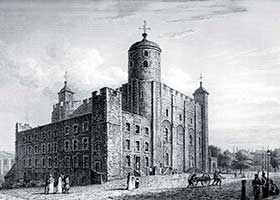| | The Bowyer Tower
The History of the Tower of London is great, bloody and cruel and the Bowyer Tower has its part to play in its story. Bowyer Tower is just one of the 21 towers which, together, form the Tower of London castle complex. The Tower of London covers an area of 18 acres and its magnificent architecture covers almost all the styles which have flourished in England. Although the Tower is no longer a place of great military strength it has in time past been a fortress, a palace, and a prison. This section provides key facts and information about the Bowyer Tower. The Purpose of the Bowyer Tower
The purpose of the Bowyer Tower changed according to the requirements of the era. | | | |
| | In general terms the towers were built for accommodation, including prisons, and as gateways protecting the Tower of London concentric castle complex. The concentric castle design ensured protection of the Tower of London with successive lines of fortification - many of the different towers were gradually added, over many hundreds of years, providing additional protection. Specific facts and info about which English King was responsible for building the towers, when the towers were built, the style of architecture and interesting info about its history. |
Bowyer TowerBowyer Tower - Information & Facts about the Bowyer Tower
- Key Dates in history
- Who built the Bowyer Tower in the great Tower of London?
- Information & Facts about when the Bowyer Tower was built in the Tower of London
The Bowyer Tower - Key Facts and Information - The Bowyer Tower was built by King Henry III
- The date the Bowyer Tower was built was between 1238 - 1272
- The Chief Architect and Master Builder of the Bowyer Tower was Henry de Reyns together with John of Gloucester and Robert of Beverley
- The Architecture / Style of the Medieval Bowyer Tower is described as Norman (Romanesque)
- History - Like the Broad Arrow Tower the Bowyer was named named for the royal bowmakers who lived there. According to the plays of William
- Shakespeare George, Duke of Clarence who was imprisoned in the Bowyer for treason against his brother, King Edward IV. In 1478 he died in the Bowyer tower supposedly by drowning in a barrel or butt of malmsey wine
The Bowyer Tower
The very walls of the Bowyer Tower contain some of the bloody secrets and the of the history of the Tower of London. Which King was responsible for building the Bowyer Tower and what was his reason? When was it built? Interesting facts and info about the history of the Tower of London! |
Bowyer Tower | | | The Tower of London - The History of The Tower of London
- Information & Facts about The Tower of London
- The Design, Layout and Architecture of The Tower of London - the different Towers
- The Tower of London Timeline
- The Tower of London Prisoners
- The Executions and Beheading of men and women
The Tower of London |
|
|

